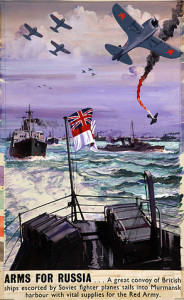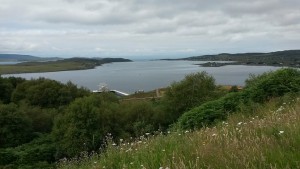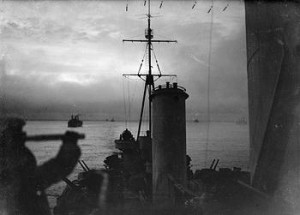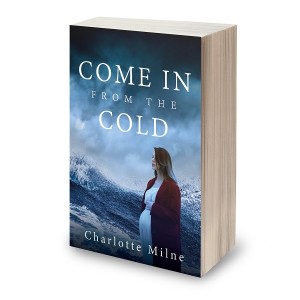 Relevant History welcomes Charlotte Milne, a naval daughter who grew up in the Scottish Borders. She worked for the Scottish National Trust, Makerere University in Uganda, and for an American software house. Although writing ‘stories’ since schooldays, she published her first novel, Dolphin Days, in 2017. Come In From the Cold (summer 2019 release), set in Scotland, tells the story of a WW2 naval officer on Russian convoys, through three generations, solving a seventy-year old murder mystery on the way. Charlotte is a keen genealogist and involved in various community-based organisations. To learn more about her and her books, visit her web site, and follow her on Facebook and Goodreads.
Relevant History welcomes Charlotte Milne, a naval daughter who grew up in the Scottish Borders. She worked for the Scottish National Trust, Makerere University in Uganda, and for an American software house. Although writing ‘stories’ since schooldays, she published her first novel, Dolphin Days, in 2017. Come In From the Cold (summer 2019 release), set in Scotland, tells the story of a WW2 naval officer on Russian convoys, through three generations, solving a seventy-year old murder mystery on the way. Charlotte is a keen genealogist and involved in various community-based organisations. To learn more about her and her books, visit her web site, and follow her on Facebook and Goodreads.
*****
 In World War 2, Roosevelt and Churchill desperately needed to prevent Russia from allying with Germany. If it did so, they knew the western allies would lose the war. In return for Russia’s alliance with the West, Stalin demanded vast amounts of food and arms for his starving and ill-equipped people. Germany and its allies blocked the land routes, so the only way to get supplies to Russia was by sea. The only ports available were within the Arctic Circle—Murmansk and Archangel—with all of Hitler’s sea and air power under orders to prevent them from reaching Russia.
In World War 2, Roosevelt and Churchill desperately needed to prevent Russia from allying with Germany. If it did so, they knew the western allies would lose the war. In return for Russia’s alliance with the West, Stalin demanded vast amounts of food and arms for his starving and ill-equipped people. Germany and its allies blocked the land routes, so the only way to get supplies to Russia was by sea. The only ports available were within the Arctic Circle—Murmansk and Archangel—with all of Hitler’s sea and air power under orders to prevent them from reaching Russia.
How did Britain and the US get supplies to Russia?
 Merchant ships gathered in a deep-water anchorage in the west of Scotland called Loch Ewe. Protected by escorts of heavily-armed allied warships, they joined up with other merchant ships in Iceland, and headed, nervously, towards Russia’s only two northern open-water ports.
Merchant ships gathered in a deep-water anchorage in the west of Scotland called Loch Ewe. Protected by escorts of heavily-armed allied warships, they joined up with other merchant ships in Iceland, and headed, nervously, towards Russia’s only two northern open-water ports.
On the way, the Luftwaffe, based in occupied Norway, would bomb the ships from the air, U-boat submarines lurking beneath the White Sea would attack with torpedoes, and their fast and mighty warships could outgun the Western allies.
We think these days that communication is so simple! Hard to remember that there was no internet, no satellites, and radar was a new technology. Radio silence was kept, to obscure the convoy’s position. Ship to ship communication was by visual signal only.
The weather was a worse enemy. In summer there was 24-hour daylight—enemy aircraft, ships and submarines worked round the clock too. Summer convoys became so dangerous they had to be discontinued. In winter there was 24-hour darkness, the sea froze and the ice sheet grew rapidly from north to south. This meant that convoys had to sail much further south and were then squeezed between the ice and the land mass to the south. Much easier for the Germans to find and attack them.
 Winter storms were indescribable. The winter water temperature often dropped to minus 2 degrees Celsius, air temperature down to minus 22 degrees Celsius, without taking wind into account. Waves were often 40 to 50 feet high, visibility was nil in driving snow and spray, ships came near the vertical both going up and coming down the waves, they crashed and bounced and wallowed and capsized. Capsizing was one of the greatest dangers due to the weight of ice which accumulated above decks from the water flooding the superstructure of ships. Ice accumulated on guns, turrets and shells; masts, rigging, funnels, pipes and guard rails; on containers, aircraft, tanks and munitions stacked on decks, the decks themselves were like ice rinks, doors sealed themselves, ropes, anchors, fenders became as hard as iron and as immoveable. Clothes were inadequate—no ski jackets or cold weather gear as we know it. Crews had to spend hours on deck, tossed about like dolls, chipping at the ice and throwing it overboard, just so that the ship would not turn turtle. Fuel and oil coagulated in the low temperatures. Unimaginable conditions. Unimaginably brave men.
Winter storms were indescribable. The winter water temperature often dropped to minus 2 degrees Celsius, air temperature down to minus 22 degrees Celsius, without taking wind into account. Waves were often 40 to 50 feet high, visibility was nil in driving snow and spray, ships came near the vertical both going up and coming down the waves, they crashed and bounced and wallowed and capsized. Capsizing was one of the greatest dangers due to the weight of ice which accumulated above decks from the water flooding the superstructure of ships. Ice accumulated on guns, turrets and shells; masts, rigging, funnels, pipes and guard rails; on containers, aircraft, tanks and munitions stacked on decks, the decks themselves were like ice rinks, doors sealed themselves, ropes, anchors, fenders became as hard as iron and as immoveable. Clothes were inadequate—no ski jackets or cold weather gear as we know it. Crews had to spend hours on deck, tossed about like dolls, chipping at the ice and throwing it overboard, just so that the ship would not turn turtle. Fuel and oil coagulated in the low temperatures. Unimaginable conditions. Unimaginably brave men.
The convoys drained the British war effort. Every escorting warship was a ship which could have been fighting elsewhere on the warfront. Churchill became extremely unpopular for supplying Russia.
In total, 104 Allied merchant ships and 18 warships were sunk on the Arctic convoys. 829 merchant mariners and 1,944 navy personnel were killed. Killed by guns, torpedoes, sinking, drowning, fire, hypothermia, inhalation of oil and Russian hospitals.
What happened when ships arrived in Russia?
Both Archangel in the White Sea and Murmansk in the Kola Inlet were very basic fishing ports. Wooden quays, virtually no lifting gear, wooden sheds, no hotels or shops of any kind. The officials were deeply suspicious of the capitalists bringing ships and goods into their country. These ports were so far from central government that orders seldom got to them. There was no infrastructure or telephones, and in winter, they were totally isolated. Murmansk was very close to German airfields in Norway, and many ships were bombed lying alongside. Ships companies were not allowed ashore—there was nothing to go ashore for! They were not allowed to use their own boats, even to visit their own ships. Russian guards were posted at every gangplank, bureaucracy was rampant and corrupt, and few Russians were able to speak English or could read or write.
Goods were mainly unloaded by hand by what appeared to be slave labour—serfs—and seldom found their way to the right destination, food supplies for the starving citizens often lying rotting on the quays. Tanks, guns, crated aircraft, munitions—no-one seemed to know who or where they were destined for, nor did anyone seem to care. Many sailors arrived with terrible injuries after German attacks, but the ‘hospital’ was so basic, with no hygiene, facilities or medications, that many died needlessly in ghastly conditions. Western medical supplies were turned away. Many of the RAF planes which should have been protecting Murmansk and attacking German airfields were grounded, but the spare parts brought on the convoys were not allowed to be delivered and were impounded or stolen along with vast amounts of vital war supplies.
The bureaucracy surrounding every movement of every man and every ship, every container and every item transported was such that sometimes it took weeks or months to offload vital supplies for the Russian front line, trapping the escorts in port. Ships were prevented from refuelling, or taking on water or food supplies, their crews virtually starving, despite bringing hundreds of tons of foodstuffs into the country. Stalin might have been an official ally, but for the Arctic convoys, Russia certainly didn’t behave like one.
The story of the Road to Russia and the sacrifice and bravery of those seamen remained almost unknown under The Official Secrets Act. Until 1999 there was no memorial, and no medal was awarded until 2013.
*****
 A big thanks to Charlotte Milne! She’ll give away one £5 Amazon gift card to a reader in the UK who contributes a comment on my blog this week as well as one $5 Amazon gift card to a reader in the United States or Canada who contributes a comment. I’ll choose the two winners from among those who comment by Friday at 6 p.m. ET.
A big thanks to Charlotte Milne! She’ll give away one £5 Amazon gift card to a reader in the UK who contributes a comment on my blog this week as well as one $5 Amazon gift card to a reader in the United States or Canada who contributes a comment. I’ll choose the two winners from among those who comment by Friday at 6 p.m. ET.
**********
Did you like what you read? Learn about downloads, discounts, and special offers from Relevant History authors and Suzanne Adair. Subscribe to Suzanne’s free newsletter.

Having lived 60 miles below the Arctic Circle in Alaska, I understand something of the winter storms you describe. It’s amazing more men didn’t die under those circumstances. I’m curious about the reference to Russian hospitals. Were they inadequate because of lack of supplies?
Thanks for the post. It’s a truly little known part of history.
Hi Karen, It must have been quite an experience living in Alaska through those winters. The Russian hospitals were more like prison camps and men who went in were often unable to get out and died there. Their ships officers were not allowed to visit or communicate with the patients. It appears that Western medicine was virtually unknown, and penicillin certainly not available, so there was deep suspicion. Also, pride seems to have been a reason for turning away aid. Fascinatingly awful! Thanks for reading the post.Hope you like the book, in due course! Charlotte Milne
I have really been enjoying WW II historical fiction books. I am a nurse at the Veteran’s Hospital and our remaining WW II vets are fewer in numbers. They are true heroes: US and British Allies – so glad that you are telling their story. I hope that your book will be available in the US and I really look forward to reading more about this time.
Hello Bernadette
How wonderful to nurse some of these amazing men. When that generation passes there will be such a void of personal experience.
My story is of course fiction, and my WW2 hero has experienced more convoys than was normal, but however many or few their journeys to Russia, they were incredibly brave. I will make the book available in the US and Canada as so many of their vets went through it too.
With best wishes
Having a great uncle, who served in the Royal Navy on two ships, that were torpedoed and taking several tours on the HMCS Haida, have made me aware of the dangers, that these sailors faced. This sounds like a fascinating book.
Hello Denise
How fascinating to have a great uncle in the RN. I wonder if you were able to talk to him about it ever? My father did not want to talk about his experiences and I never insisted. I wish I had now.
I read a book by Leona Thomas Through Ice and Fire about her father who was on the convoys. It’s fascinating. (I shouldn’t be promoting other people’s books, should I!)
Thanks for your interest and hope you like Come In From The Cold when it eventually arrives!
Because my parents were swept up in the Holocaust, I’ve read tons of books about WW II from every angle, and found this column fascinating. I did notice, though, that there’s no mention of the pact between Russian and Germany signed in 1939. There’s a terrific book about that relatively short period in which they were allies, Devils Alliance: https://www.theguardian.com/books/2014/aug/06/devils-alliance-hitlers-pact-stalin-1938-1941-roger-moorhouse-review
Hello Lev
I know very little about that time, and will get hold of the Devils Alliance. Thanks for the link. My novel reaches over three generations, from WW2 to contemporary, so a very great deal had to be left out! I’d love to write about that period of WW2 and the convoys in more detail. I’m such a slow writer it may take a while!
Best wishes.
Alistair MacLean’s San Andreas was my Introduction to the sacrifices made to deliver supplies to the USSR. It is disheartening to know of the waste made of those goods, but I look forward to a nonfiction look.
Best wishes for your book.
Hello Liz
Yes, In my post I concentrated on the waste and suspicion from the Russians, because that is the little known historical aspect of the convoys. Of course, the larger political aspect was very important and both Churchill and Roosevelt had sound political reasons, complicated though they were. All war is wasteful, isn’t it? My book is fiction though based on fact. I haven’t read San Andreas for years. Must go back to it! Best wishes.
Really interesting article. I enjoy reading books set during this period in history.
Delighted you found it interesting. Hope you enjoy my novel too.
Fascinating and disturbing. Decades ado, I read some books set around the convoys but was never aware of the real details or horrors. I’m about to read a non-fiction history about the Soviet female pilots – Elizabeth Wein’s A Thousand Sisters, so I wonder what I will learn from her research on the period.
I agree that some of the details are disturbing. I guess that much of history is whitewashed, or made heroic, when in fact it was just plain ghastly. Those on the convoys were just doing what they’d signed up to do, including obeying orders! We as a generation are so blessed to have been part of the ‘peace period’.
Pingback: Interview With Author Charlotte Milne | NFReads.com